Engineering Management Report: Parcel Post Delivery Project Analysis
VerifiedAdded on 2020/03/23
|14
|3006
|75
Report
AI Summary
This report provides a detailed analysis of a parcel post delivery project aimed at upgrading technology, specifically focusing on the implementation of RFID tags and readers to replace barcodes. The project scope encompasses defining goals, tasks, expenses, and deadlines, with the primary objective of increasing parcel visibility and reducing losses. The report outlines project priorities, including the fitting of RFID tags, outsourcing software development, and fitting sensors to trucks. It includes a work breakdown structure (WBS) that categorizes tasks into manageable segments. A risk breakdown structure (RBS) is also presented, identifying and evaluating technical, external, organizational, and project-related risks. The report also discusses risk treatment strategies, such as vendor evaluation, power backup, and data protection. Overall, the project aims to improve efficiency, reduce errors, and enhance customer satisfaction through technological upgrades and robust project management.
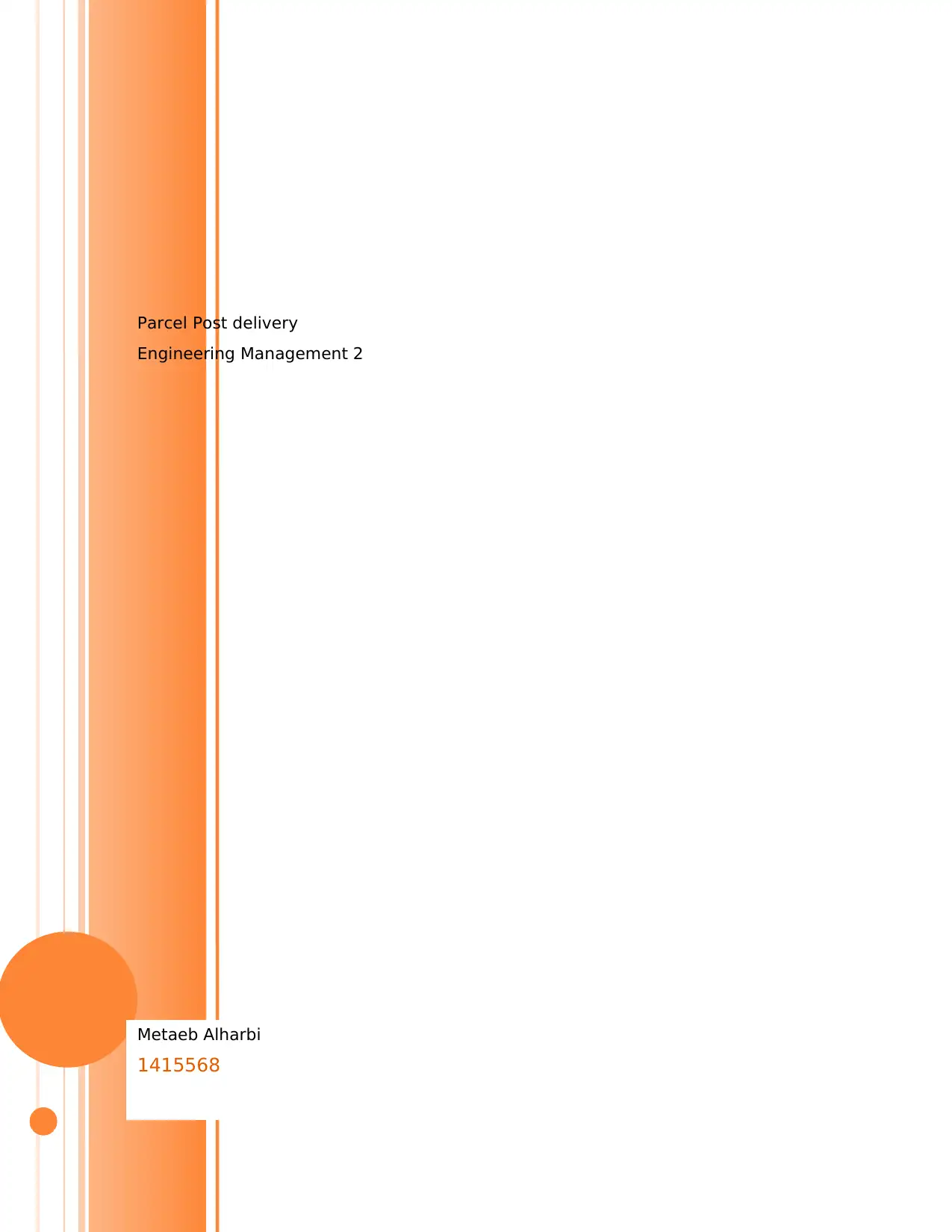
Metaeb Alharbi
1415568
Parcel Post delivery
Engineering Management 2
1415568
Parcel Post delivery
Engineering Management 2
Paraphrase This Document
Need a fresh take? Get an instant paraphrase of this document with our AI Paraphraser
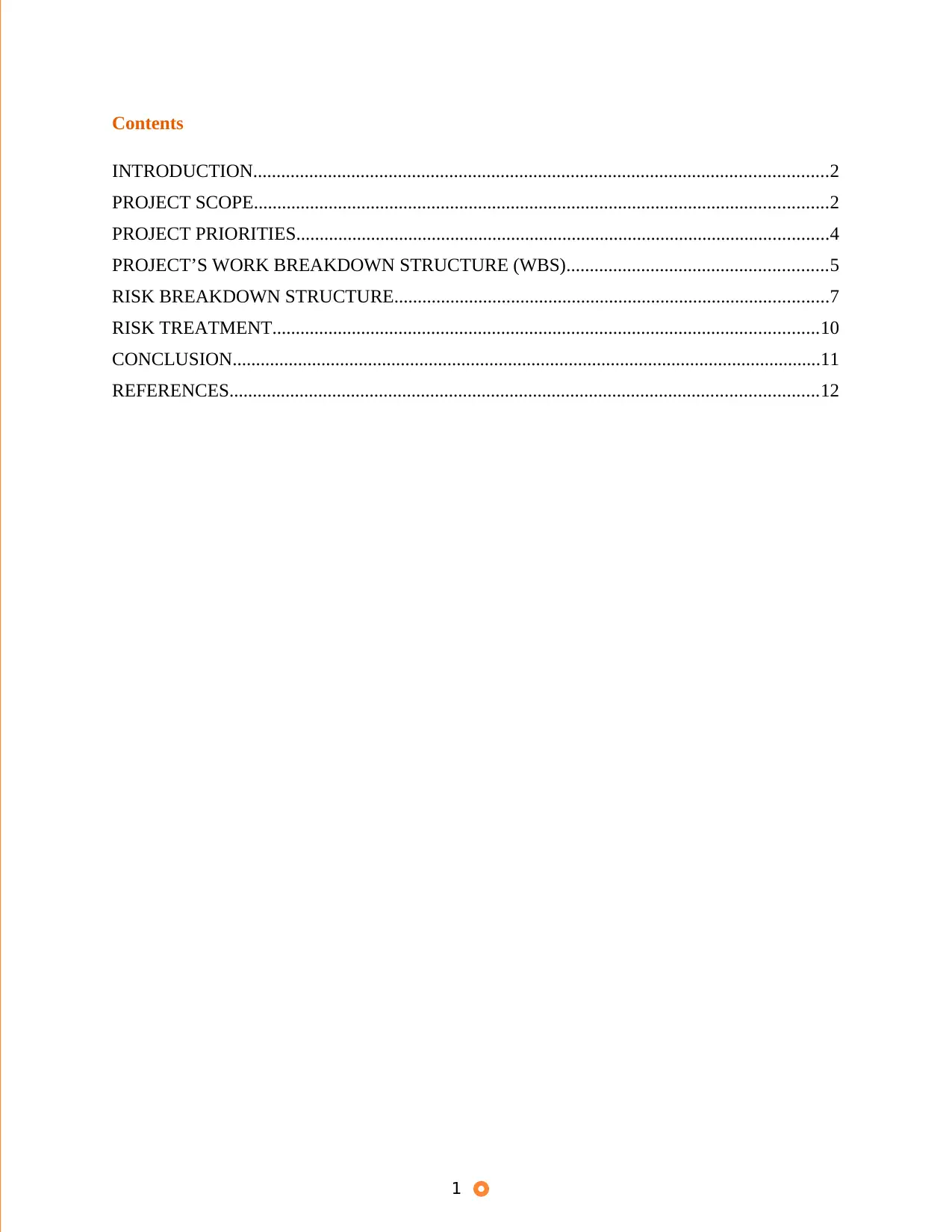
Contents
INTRODUCTION...........................................................................................................................2
PROJECT SCOPE...........................................................................................................................2
PROJECT PRIORITIES..................................................................................................................4
PROJECT’S WORK BREAKDOWN STRUCTURE (WBS)........................................................5
RISK BREAKDOWN STRUCTURE.............................................................................................7
RISK TREATMENT.....................................................................................................................10
CONCLUSION..............................................................................................................................11
REFERENCES..............................................................................................................................12
1
INTRODUCTION...........................................................................................................................2
PROJECT SCOPE...........................................................................................................................2
PROJECT PRIORITIES..................................................................................................................4
PROJECT’S WORK BREAKDOWN STRUCTURE (WBS)........................................................5
RISK BREAKDOWN STRUCTURE.............................................................................................7
RISK TREATMENT.....................................................................................................................10
CONCLUSION..............................................................................................................................11
REFERENCES..............................................................................................................................12
1
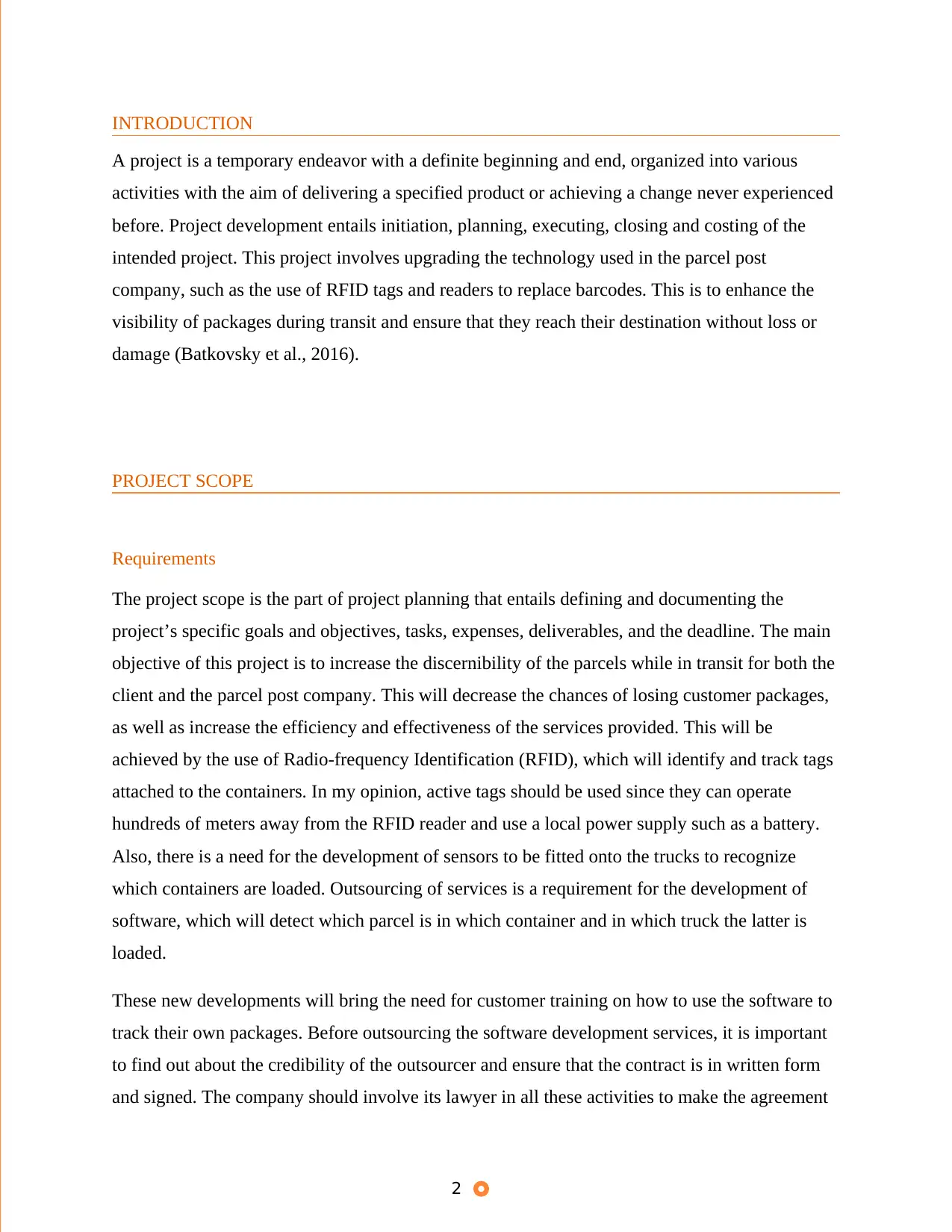
INTRODUCTION
A project is a temporary endeavor with a definite beginning and end, organized into various
activities with the aim of delivering a specified product or achieving a change never experienced
before. Project development entails initiation, planning, executing, closing and costing of the
intended project. This project involves upgrading the technology used in the parcel post
company, such as the use of RFID tags and readers to replace barcodes. This is to enhance the
visibility of packages during transit and ensure that they reach their destination without loss or
damage (Batkovsky et al., 2016).
PROJECT SCOPE
Requirements
The project scope is the part of project planning that entails defining and documenting the
project’s specific goals and objectives, tasks, expenses, deliverables, and the deadline. The main
objective of this project is to increase the discernibility of the parcels while in transit for both the
client and the parcel post company. This will decrease the chances of losing customer packages,
as well as increase the efficiency and effectiveness of the services provided. This will be
achieved by the use of Radio-frequency Identification (RFID), which will identify and track tags
attached to the containers. In my opinion, active tags should be used since they can operate
hundreds of meters away from the RFID reader and use a local power supply such as a battery.
Also, there is a need for the development of sensors to be fitted onto the trucks to recognize
which containers are loaded. Outsourcing of services is a requirement for the development of
software, which will detect which parcel is in which container and in which truck the latter is
loaded.
These new developments will bring the need for customer training on how to use the software to
track their own packages. Before outsourcing the software development services, it is important
to find out about the credibility of the outsourcer and ensure that the contract is in written form
and signed. The company should involve its lawyer in all these activities to make the agreement
2
A project is a temporary endeavor with a definite beginning and end, organized into various
activities with the aim of delivering a specified product or achieving a change never experienced
before. Project development entails initiation, planning, executing, closing and costing of the
intended project. This project involves upgrading the technology used in the parcel post
company, such as the use of RFID tags and readers to replace barcodes. This is to enhance the
visibility of packages during transit and ensure that they reach their destination without loss or
damage (Batkovsky et al., 2016).
PROJECT SCOPE
Requirements
The project scope is the part of project planning that entails defining and documenting the
project’s specific goals and objectives, tasks, expenses, deliverables, and the deadline. The main
objective of this project is to increase the discernibility of the parcels while in transit for both the
client and the parcel post company. This will decrease the chances of losing customer packages,
as well as increase the efficiency and effectiveness of the services provided. This will be
achieved by the use of Radio-frequency Identification (RFID), which will identify and track tags
attached to the containers. In my opinion, active tags should be used since they can operate
hundreds of meters away from the RFID reader and use a local power supply such as a battery.
Also, there is a need for the development of sensors to be fitted onto the trucks to recognize
which containers are loaded. Outsourcing of services is a requirement for the development of
software, which will detect which parcel is in which container and in which truck the latter is
loaded.
These new developments will bring the need for customer training on how to use the software to
track their own packages. Before outsourcing the software development services, it is important
to find out about the credibility of the outsourcer and ensure that the contract is in written form
and signed. The company should involve its lawyer in all these activities to make the agreement
2
⊘ This is a preview!⊘
Do you want full access?
Subscribe today to unlock all pages.

Trusted by 1+ million students worldwide
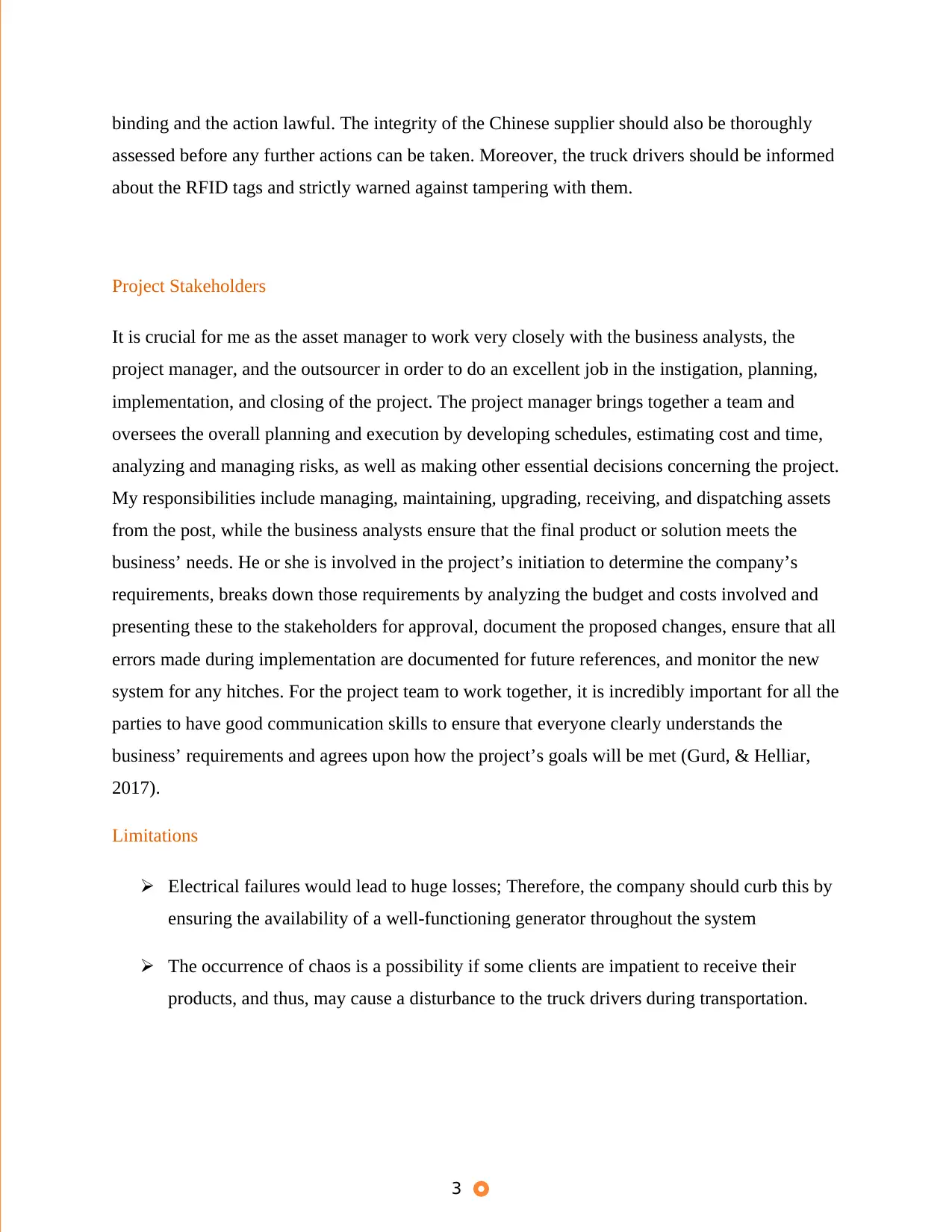
binding and the action lawful. The integrity of the Chinese supplier should also be thoroughly
assessed before any further actions can be taken. Moreover, the truck drivers should be informed
about the RFID tags and strictly warned against tampering with them.
Project Stakeholders
It is crucial for me as the asset manager to work very closely with the business analysts, the
project manager, and the outsourcer in order to do an excellent job in the instigation, planning,
implementation, and closing of the project. The project manager brings together a team and
oversees the overall planning and execution by developing schedules, estimating cost and time,
analyzing and managing risks, as well as making other essential decisions concerning the project.
My responsibilities include managing, maintaining, upgrading, receiving, and dispatching assets
from the post, while the business analysts ensure that the final product or solution meets the
business’ needs. He or she is involved in the project’s initiation to determine the company’s
requirements, breaks down those requirements by analyzing the budget and costs involved and
presenting these to the stakeholders for approval, document the proposed changes, ensure that all
errors made during implementation are documented for future references, and monitor the new
system for any hitches. For the project team to work together, it is incredibly important for all the
parties to have good communication skills to ensure that everyone clearly understands the
business’ requirements and agrees upon how the project’s goals will be met (Gurd, & Helliar,
2017).
Limitations
Electrical failures would lead to huge losses; Therefore, the company should curb this by
ensuring the availability of a well-functioning generator throughout the system
The occurrence of chaos is a possibility if some clients are impatient to receive their
products, and thus, may cause a disturbance to the truck drivers during transportation.
3
assessed before any further actions can be taken. Moreover, the truck drivers should be informed
about the RFID tags and strictly warned against tampering with them.
Project Stakeholders
It is crucial for me as the asset manager to work very closely with the business analysts, the
project manager, and the outsourcer in order to do an excellent job in the instigation, planning,
implementation, and closing of the project. The project manager brings together a team and
oversees the overall planning and execution by developing schedules, estimating cost and time,
analyzing and managing risks, as well as making other essential decisions concerning the project.
My responsibilities include managing, maintaining, upgrading, receiving, and dispatching assets
from the post, while the business analysts ensure that the final product or solution meets the
business’ needs. He or she is involved in the project’s initiation to determine the company’s
requirements, breaks down those requirements by analyzing the budget and costs involved and
presenting these to the stakeholders for approval, document the proposed changes, ensure that all
errors made during implementation are documented for future references, and monitor the new
system for any hitches. For the project team to work together, it is incredibly important for all the
parties to have good communication skills to ensure that everyone clearly understands the
business’ requirements and agrees upon how the project’s goals will be met (Gurd, & Helliar,
2017).
Limitations
Electrical failures would lead to huge losses; Therefore, the company should curb this by
ensuring the availability of a well-functioning generator throughout the system
The occurrence of chaos is a possibility if some clients are impatient to receive their
products, and thus, may cause a disturbance to the truck drivers during transportation.
3
Paraphrase This Document
Need a fresh take? Get an instant paraphrase of this document with our AI Paraphraser
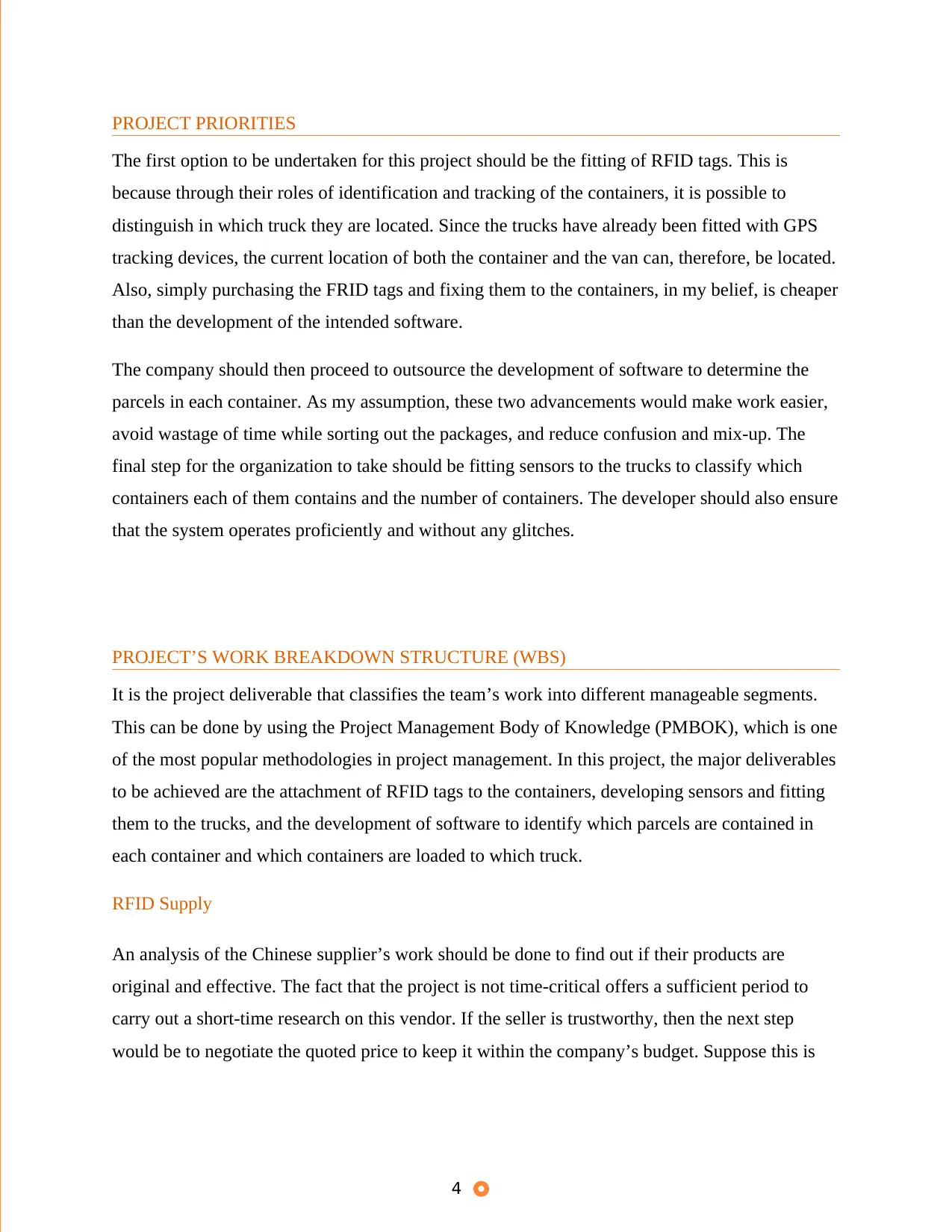
PROJECT PRIORITIES
The first option to be undertaken for this project should be the fitting of RFID tags. This is
because through their roles of identification and tracking of the containers, it is possible to
distinguish in which truck they are located. Since the trucks have already been fitted with GPS
tracking devices, the current location of both the container and the van can, therefore, be located.
Also, simply purchasing the FRID tags and fixing them to the containers, in my belief, is cheaper
than the development of the intended software.
The company should then proceed to outsource the development of software to determine the
parcels in each container. As my assumption, these two advancements would make work easier,
avoid wastage of time while sorting out the packages, and reduce confusion and mix-up. The
final step for the organization to take should be fitting sensors to the trucks to classify which
containers each of them contains and the number of containers. The developer should also ensure
that the system operates proficiently and without any glitches.
PROJECT’S WORK BREAKDOWN STRUCTURE (WBS)
It is the project deliverable that classifies the team’s work into different manageable segments.
This can be done by using the Project Management Body of Knowledge (PMBOK), which is one
of the most popular methodologies in project management. In this project, the major deliverables
to be achieved are the attachment of RFID tags to the containers, developing sensors and fitting
them to the trucks, and the development of software to identify which parcels are contained in
each container and which containers are loaded to which truck.
RFID Supply
An analysis of the Chinese supplier’s work should be done to find out if their products are
original and effective. The fact that the project is not time-critical offers a sufficient period to
carry out a short-time research on this vendor. If the seller is trustworthy, then the next step
would be to negotiate the quoted price to keep it within the company’s budget. Suppose this is
4
The first option to be undertaken for this project should be the fitting of RFID tags. This is
because through their roles of identification and tracking of the containers, it is possible to
distinguish in which truck they are located. Since the trucks have already been fitted with GPS
tracking devices, the current location of both the container and the van can, therefore, be located.
Also, simply purchasing the FRID tags and fixing them to the containers, in my belief, is cheaper
than the development of the intended software.
The company should then proceed to outsource the development of software to determine the
parcels in each container. As my assumption, these two advancements would make work easier,
avoid wastage of time while sorting out the packages, and reduce confusion and mix-up. The
final step for the organization to take should be fitting sensors to the trucks to classify which
containers each of them contains and the number of containers. The developer should also ensure
that the system operates proficiently and without any glitches.
PROJECT’S WORK BREAKDOWN STRUCTURE (WBS)
It is the project deliverable that classifies the team’s work into different manageable segments.
This can be done by using the Project Management Body of Knowledge (PMBOK), which is one
of the most popular methodologies in project management. In this project, the major deliverables
to be achieved are the attachment of RFID tags to the containers, developing sensors and fitting
them to the trucks, and the development of software to identify which parcels are contained in
each container and which containers are loaded to which truck.
RFID Supply
An analysis of the Chinese supplier’s work should be done to find out if their products are
original and effective. The fact that the project is not time-critical offers a sufficient period to
carry out a short-time research on this vendor. If the seller is trustworthy, then the next step
would be to negotiate the quoted price to keep it within the company’s budget. Suppose this is
4
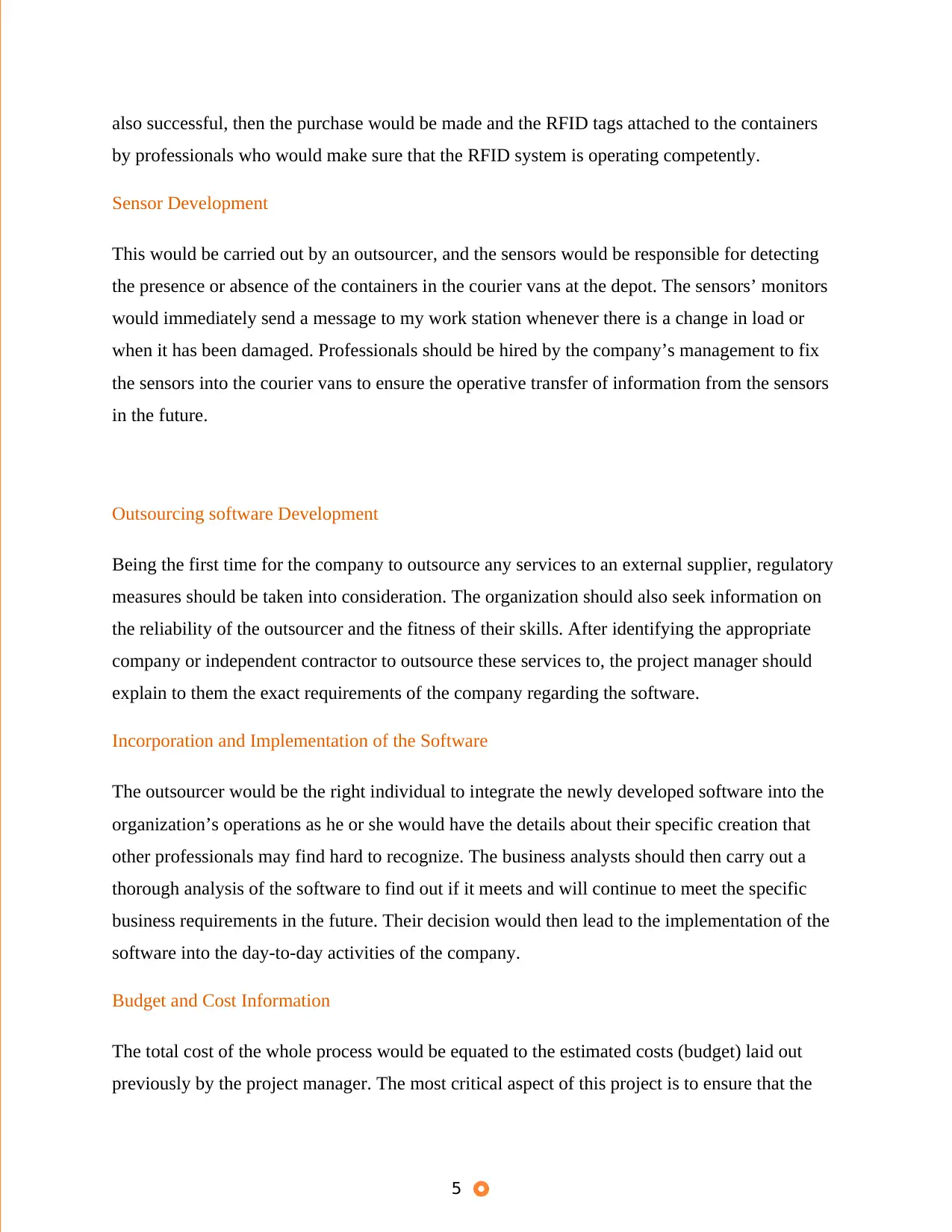
also successful, then the purchase would be made and the RFID tags attached to the containers
by professionals who would make sure that the RFID system is operating competently.
Sensor Development
This would be carried out by an outsourcer, and the sensors would be responsible for detecting
the presence or absence of the containers in the courier vans at the depot. The sensors’ monitors
would immediately send a message to my work station whenever there is a change in load or
when it has been damaged. Professionals should be hired by the company’s management to fix
the sensors into the courier vans to ensure the operative transfer of information from the sensors
in the future.
Outsourcing software Development
Being the first time for the company to outsource any services to an external supplier, regulatory
measures should be taken into consideration. The organization should also seek information on
the reliability of the outsourcer and the fitness of their skills. After identifying the appropriate
company or independent contractor to outsource these services to, the project manager should
explain to them the exact requirements of the company regarding the software.
Incorporation and Implementation of the Software
The outsourcer would be the right individual to integrate the newly developed software into the
organization’s operations as he or she would have the details about their specific creation that
other professionals may find hard to recognize. The business analysts should then carry out a
thorough analysis of the software to find out if it meets and will continue to meet the specific
business requirements in the future. Their decision would then lead to the implementation of the
software into the day-to-day activities of the company.
Budget and Cost Information
The total cost of the whole process would be equated to the estimated costs (budget) laid out
previously by the project manager. The most critical aspect of this project is to ensure that the
5
by professionals who would make sure that the RFID system is operating competently.
Sensor Development
This would be carried out by an outsourcer, and the sensors would be responsible for detecting
the presence or absence of the containers in the courier vans at the depot. The sensors’ monitors
would immediately send a message to my work station whenever there is a change in load or
when it has been damaged. Professionals should be hired by the company’s management to fix
the sensors into the courier vans to ensure the operative transfer of information from the sensors
in the future.
Outsourcing software Development
Being the first time for the company to outsource any services to an external supplier, regulatory
measures should be taken into consideration. The organization should also seek information on
the reliability of the outsourcer and the fitness of their skills. After identifying the appropriate
company or independent contractor to outsource these services to, the project manager should
explain to them the exact requirements of the company regarding the software.
Incorporation and Implementation of the Software
The outsourcer would be the right individual to integrate the newly developed software into the
organization’s operations as he or she would have the details about their specific creation that
other professionals may find hard to recognize. The business analysts should then carry out a
thorough analysis of the software to find out if it meets and will continue to meet the specific
business requirements in the future. Their decision would then lead to the implementation of the
software into the day-to-day activities of the company.
Budget and Cost Information
The total cost of the whole process would be equated to the estimated costs (budget) laid out
previously by the project manager. The most critical aspect of this project is to ensure that the
5
⊘ This is a preview!⊘
Do you want full access?
Subscribe today to unlock all pages.

Trusted by 1+ million students worldwide
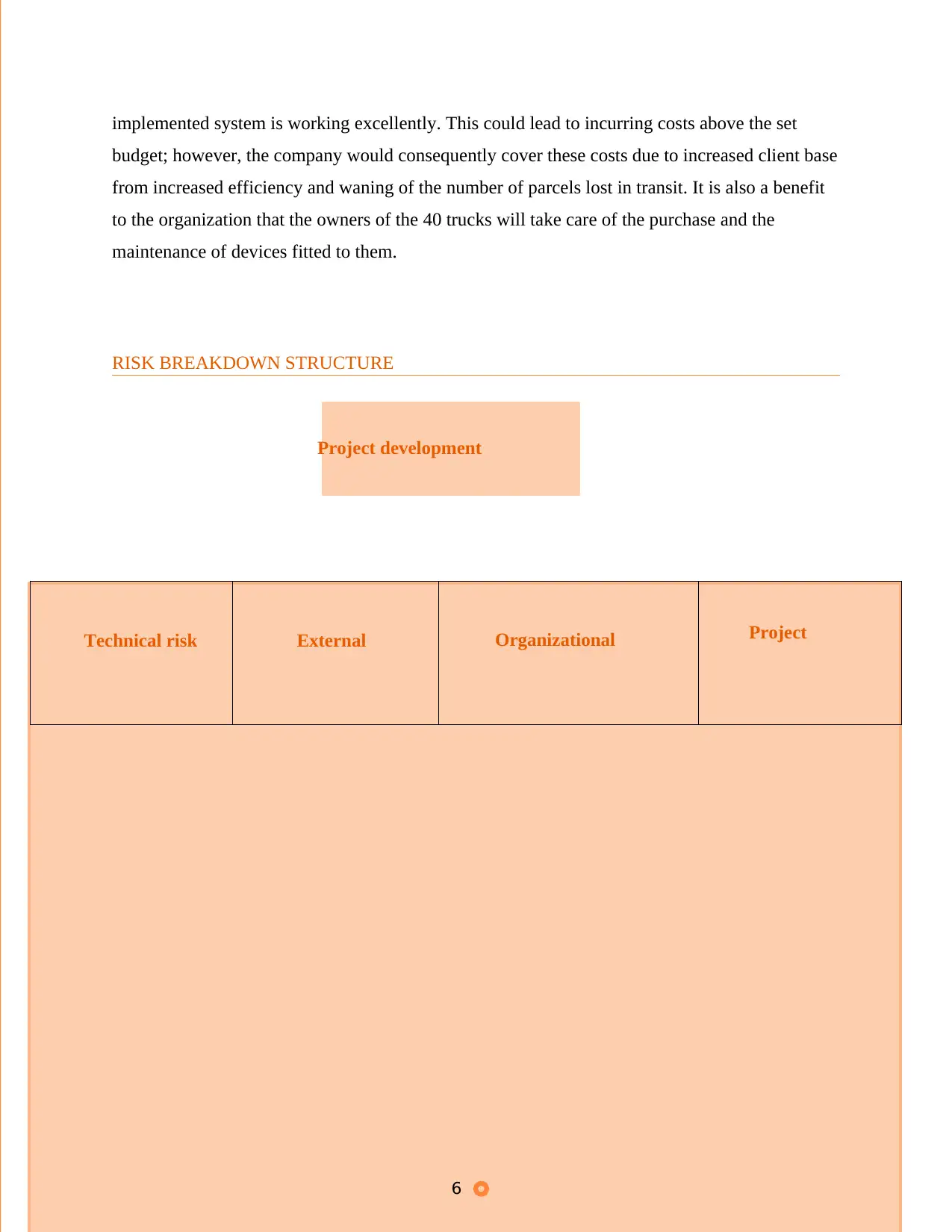
implemented system is working excellently. This could lead to incurring costs above the set
budget; however, the company would consequently cover these costs due to increased client base
from increased efficiency and waning of the number of parcels lost in transit. It is also a benefit
to the organization that the owners of the 40 trucks will take care of the purchase and the
maintenance of devices fitted to them.
RISK BREAKDOWN STRUCTURE
Project development
Technical risk External Organizational Project
6
budget; however, the company would consequently cover these costs due to increased client base
from increased efficiency and waning of the number of parcels lost in transit. It is also a benefit
to the organization that the owners of the 40 trucks will take care of the purchase and the
maintenance of devices fitted to them.
RISK BREAKDOWN STRUCTURE
Project development
Technical risk External Organizational Project
6
Paraphrase This Document
Need a fresh take? Get an instant paraphrase of this document with our AI Paraphraser
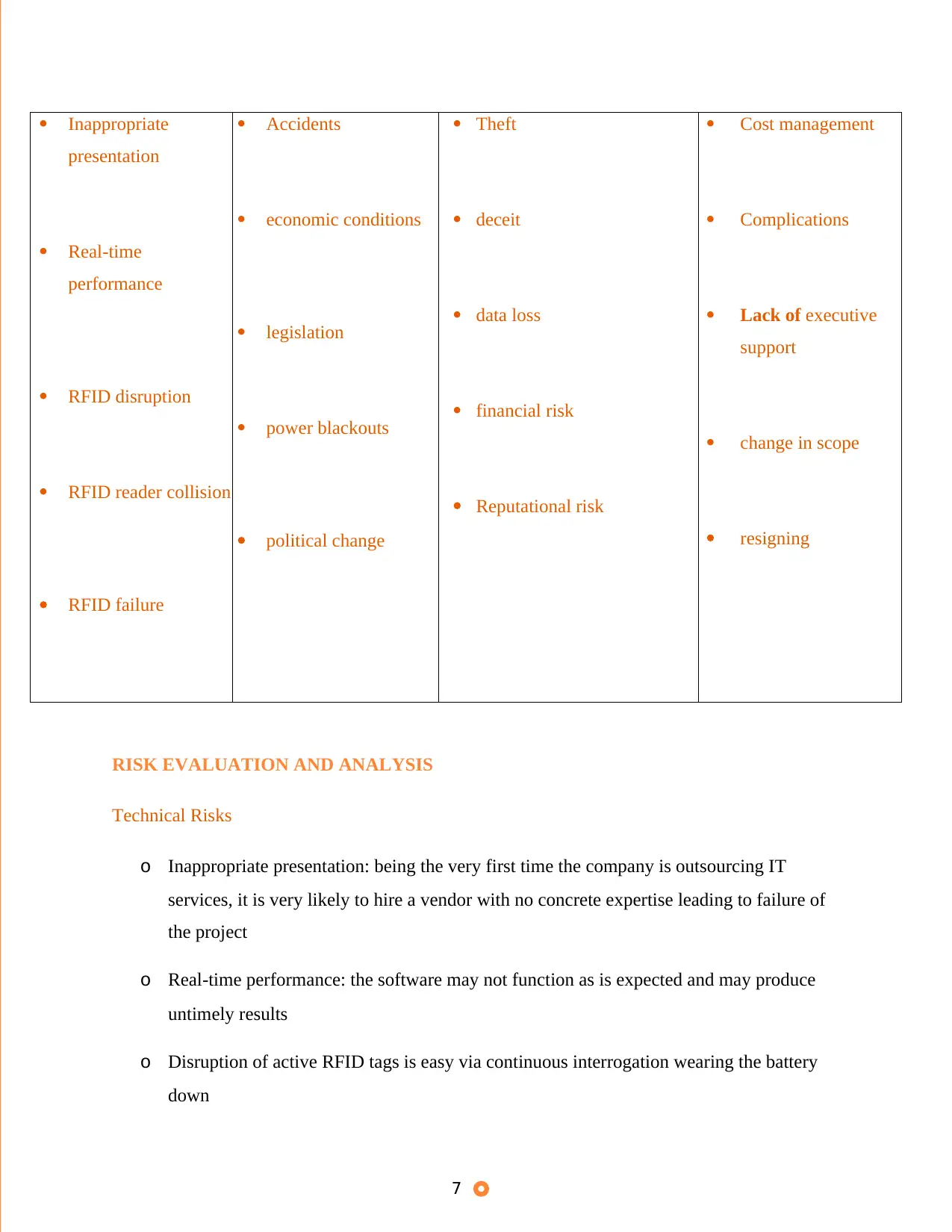
Inappropriate
presentation
Real-time
performance
RFID disruption
RFID reader collision
RFID failure
Accidents
economic conditions
legislation
power blackouts
political change
Theft
deceit
data loss
financial risk
Reputational risk
Cost management
Complications
Lack of executive
support
change in scope
resigning
RISK EVALUATION AND ANALYSIS
Technical Risks
o Inappropriate presentation: being the very first time the company is outsourcing IT
services, it is very likely to hire a vendor with no concrete expertise leading to failure of
the project
o Real-time performance: the software may not function as is expected and may produce
untimely results
o Disruption of active RFID tags is easy via continuous interrogation wearing the battery
down
7
presentation
Real-time
performance
RFID disruption
RFID reader collision
RFID failure
Accidents
economic conditions
legislation
power blackouts
political change
Theft
deceit
data loss
financial risk
Reputational risk
Cost management
Complications
Lack of executive
support
change in scope
resigning
RISK EVALUATION AND ANALYSIS
Technical Risks
o Inappropriate presentation: being the very first time the company is outsourcing IT
services, it is very likely to hire a vendor with no concrete expertise leading to failure of
the project
o Real-time performance: the software may not function as is expected and may produce
untimely results
o Disruption of active RFID tags is easy via continuous interrogation wearing the battery
down
7
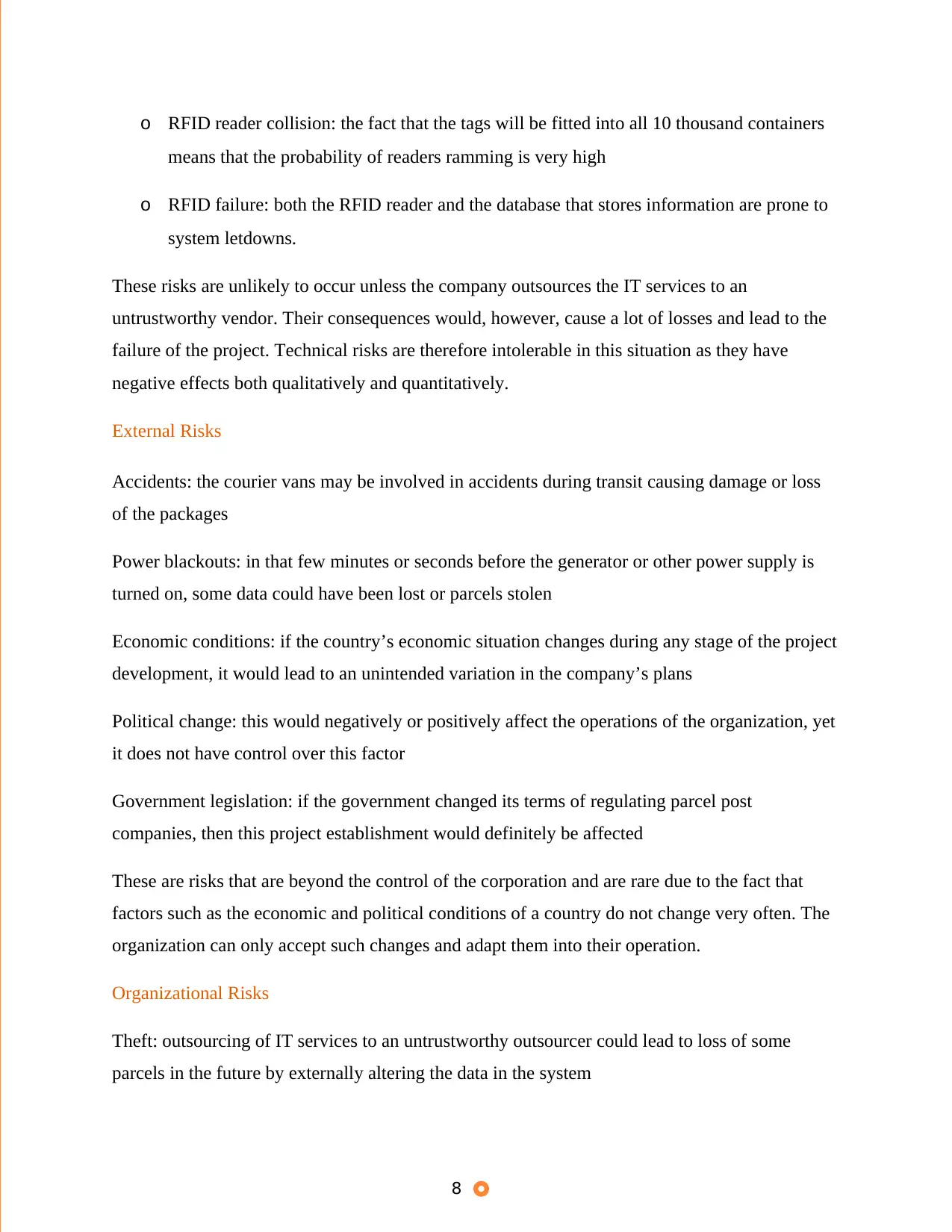
o RFID reader collision: the fact that the tags will be fitted into all 10 thousand containers
means that the probability of readers ramming is very high
o RFID failure: both the RFID reader and the database that stores information are prone to
system letdowns.
These risks are unlikely to occur unless the company outsources the IT services to an
untrustworthy vendor. Their consequences would, however, cause a lot of losses and lead to the
failure of the project. Technical risks are therefore intolerable in this situation as they have
negative effects both qualitatively and quantitatively.
External Risks
Accidents: the courier vans may be involved in accidents during transit causing damage or loss
of the packages
Power blackouts: in that few minutes or seconds before the generator or other power supply is
turned on, some data could have been lost or parcels stolen
Economic conditions: if the country’s economic situation changes during any stage of the project
development, it would lead to an unintended variation in the company’s plans
Political change: this would negatively or positively affect the operations of the organization, yet
it does not have control over this factor
Government legislation: if the government changed its terms of regulating parcel post
companies, then this project establishment would definitely be affected
These are risks that are beyond the control of the corporation and are rare due to the fact that
factors such as the economic and political conditions of a country do not change very often. The
organization can only accept such changes and adapt them into their operation.
Organizational Risks
Theft: outsourcing of IT services to an untrustworthy outsourcer could lead to loss of some
parcels in the future by externally altering the data in the system
8
means that the probability of readers ramming is very high
o RFID failure: both the RFID reader and the database that stores information are prone to
system letdowns.
These risks are unlikely to occur unless the company outsources the IT services to an
untrustworthy vendor. Their consequences would, however, cause a lot of losses and lead to the
failure of the project. Technical risks are therefore intolerable in this situation as they have
negative effects both qualitatively and quantitatively.
External Risks
Accidents: the courier vans may be involved in accidents during transit causing damage or loss
of the packages
Power blackouts: in that few minutes or seconds before the generator or other power supply is
turned on, some data could have been lost or parcels stolen
Economic conditions: if the country’s economic situation changes during any stage of the project
development, it would lead to an unintended variation in the company’s plans
Political change: this would negatively or positively affect the operations of the organization, yet
it does not have control over this factor
Government legislation: if the government changed its terms of regulating parcel post
companies, then this project establishment would definitely be affected
These are risks that are beyond the control of the corporation and are rare due to the fact that
factors such as the economic and political conditions of a country do not change very often. The
organization can only accept such changes and adapt them into their operation.
Organizational Risks
Theft: outsourcing of IT services to an untrustworthy outsourcer could lead to loss of some
parcels in the future by externally altering the data in the system
8
⊘ This is a preview!⊘
Do you want full access?
Subscribe today to unlock all pages.

Trusted by 1+ million students worldwide
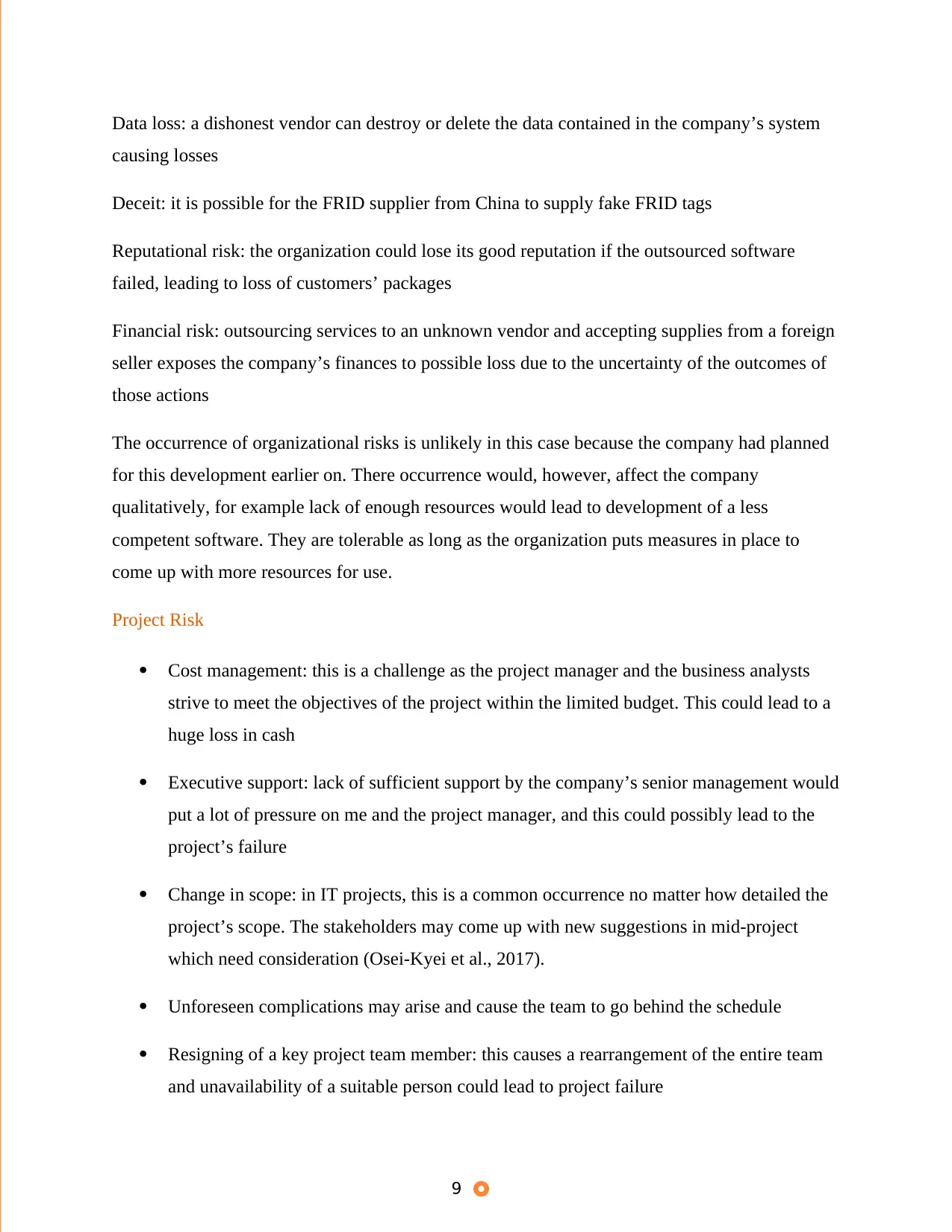
Data loss: a dishonest vendor can destroy or delete the data contained in the company’s system
causing losses
Deceit: it is possible for the FRID supplier from China to supply fake FRID tags
Reputational risk: the organization could lose its good reputation if the outsourced software
failed, leading to loss of customers’ packages
Financial risk: outsourcing services to an unknown vendor and accepting supplies from a foreign
seller exposes the company’s finances to possible loss due to the uncertainty of the outcomes of
those actions
The occurrence of organizational risks is unlikely in this case because the company had planned
for this development earlier on. There occurrence would, however, affect the company
qualitatively, for example lack of enough resources would lead to development of a less
competent software. They are tolerable as long as the organization puts measures in place to
come up with more resources for use.
Project Risk
Cost management: this is a challenge as the project manager and the business analysts
strive to meet the objectives of the project within the limited budget. This could lead to a
huge loss in cash
Executive support: lack of sufficient support by the company’s senior management would
put a lot of pressure on me and the project manager, and this could possibly lead to the
project’s failure
Change in scope: in IT projects, this is a common occurrence no matter how detailed the
project’s scope. The stakeholders may come up with new suggestions in mid-project
which need consideration (Osei-Kyei et al., 2017).
Unforeseen complications may arise and cause the team to go behind the schedule
Resigning of a key project team member: this causes a rearrangement of the entire team
and unavailability of a suitable person could lead to project failure
9
causing losses
Deceit: it is possible for the FRID supplier from China to supply fake FRID tags
Reputational risk: the organization could lose its good reputation if the outsourced software
failed, leading to loss of customers’ packages
Financial risk: outsourcing services to an unknown vendor and accepting supplies from a foreign
seller exposes the company’s finances to possible loss due to the uncertainty of the outcomes of
those actions
The occurrence of organizational risks is unlikely in this case because the company had planned
for this development earlier on. There occurrence would, however, affect the company
qualitatively, for example lack of enough resources would lead to development of a less
competent software. They are tolerable as long as the organization puts measures in place to
come up with more resources for use.
Project Risk
Cost management: this is a challenge as the project manager and the business analysts
strive to meet the objectives of the project within the limited budget. This could lead to a
huge loss in cash
Executive support: lack of sufficient support by the company’s senior management would
put a lot of pressure on me and the project manager, and this could possibly lead to the
project’s failure
Change in scope: in IT projects, this is a common occurrence no matter how detailed the
project’s scope. The stakeholders may come up with new suggestions in mid-project
which need consideration (Osei-Kyei et al., 2017).
Unforeseen complications may arise and cause the team to go behind the schedule
Resigning of a key project team member: this causes a rearrangement of the entire team
and unavailability of a suitable person could lead to project failure
9
Paraphrase This Document
Need a fresh take? Get an instant paraphrase of this document with our AI Paraphraser
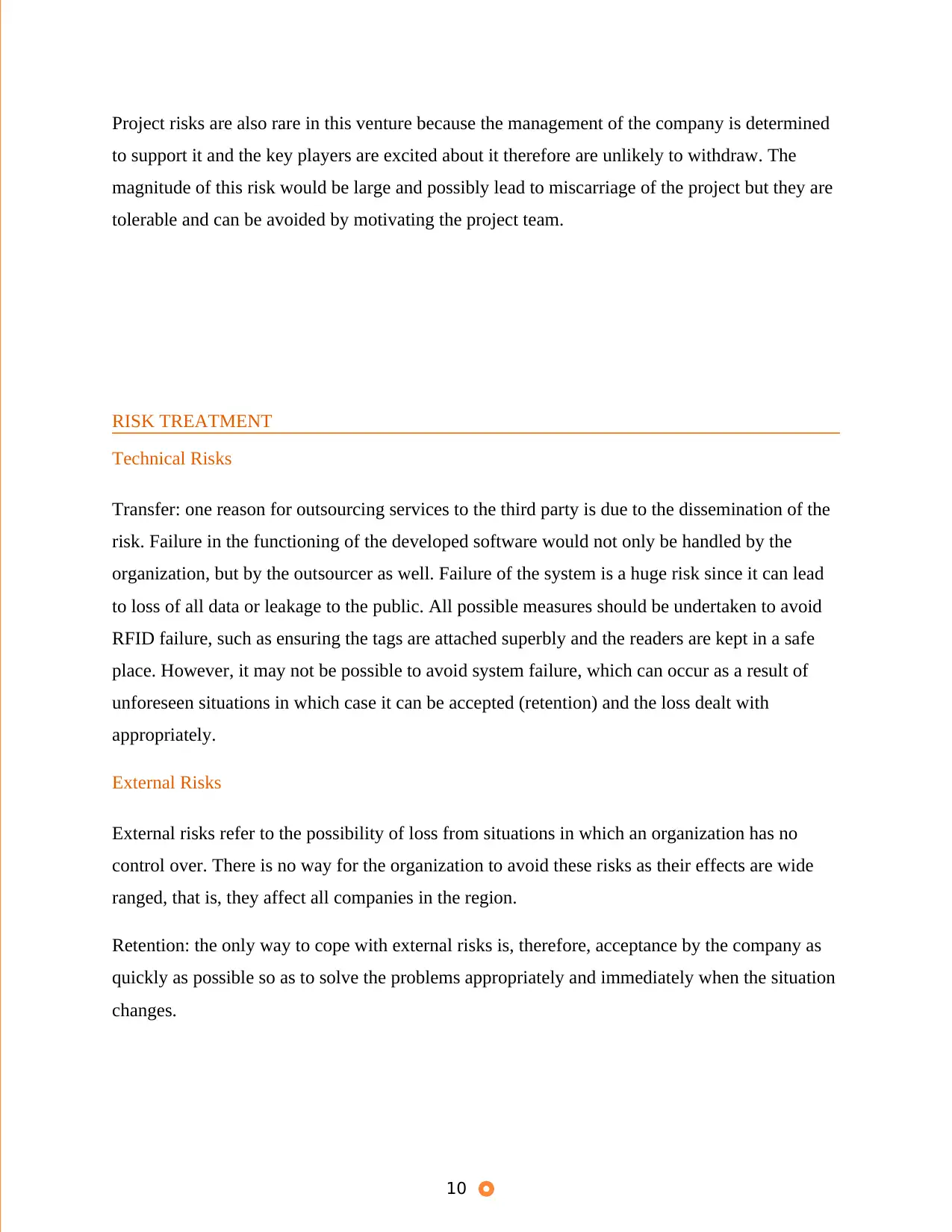
Project risks are also rare in this venture because the management of the company is determined
to support it and the key players are excited about it therefore are unlikely to withdraw. The
magnitude of this risk would be large and possibly lead to miscarriage of the project but they are
tolerable and can be avoided by motivating the project team.
RISK TREATMENT
Technical Risks
Transfer: one reason for outsourcing services to the third party is due to the dissemination of the
risk. Failure in the functioning of the developed software would not only be handled by the
organization, but by the outsourcer as well. Failure of the system is a huge risk since it can lead
to loss of all data or leakage to the public. All possible measures should be undertaken to avoid
RFID failure, such as ensuring the tags are attached superbly and the readers are kept in a safe
place. However, it may not be possible to avoid system failure, which can occur as a result of
unforeseen situations in which case it can be accepted (retention) and the loss dealt with
appropriately.
External Risks
External risks refer to the possibility of loss from situations in which an organization has no
control over. There is no way for the organization to avoid these risks as their effects are wide
ranged, that is, they affect all companies in the region.
Retention: the only way to cope with external risks is, therefore, acceptance by the company as
quickly as possible so as to solve the problems appropriately and immediately when the situation
changes.
10
to support it and the key players are excited about it therefore are unlikely to withdraw. The
magnitude of this risk would be large and possibly lead to miscarriage of the project but they are
tolerable and can be avoided by motivating the project team.
RISK TREATMENT
Technical Risks
Transfer: one reason for outsourcing services to the third party is due to the dissemination of the
risk. Failure in the functioning of the developed software would not only be handled by the
organization, but by the outsourcer as well. Failure of the system is a huge risk since it can lead
to loss of all data or leakage to the public. All possible measures should be undertaken to avoid
RFID failure, such as ensuring the tags are attached superbly and the readers are kept in a safe
place. However, it may not be possible to avoid system failure, which can occur as a result of
unforeseen situations in which case it can be accepted (retention) and the loss dealt with
appropriately.
External Risks
External risks refer to the possibility of loss from situations in which an organization has no
control over. There is no way for the organization to avoid these risks as their effects are wide
ranged, that is, they affect all companies in the region.
Retention: the only way to cope with external risks is, therefore, acceptance by the company as
quickly as possible so as to solve the problems appropriately and immediately when the situation
changes.
10
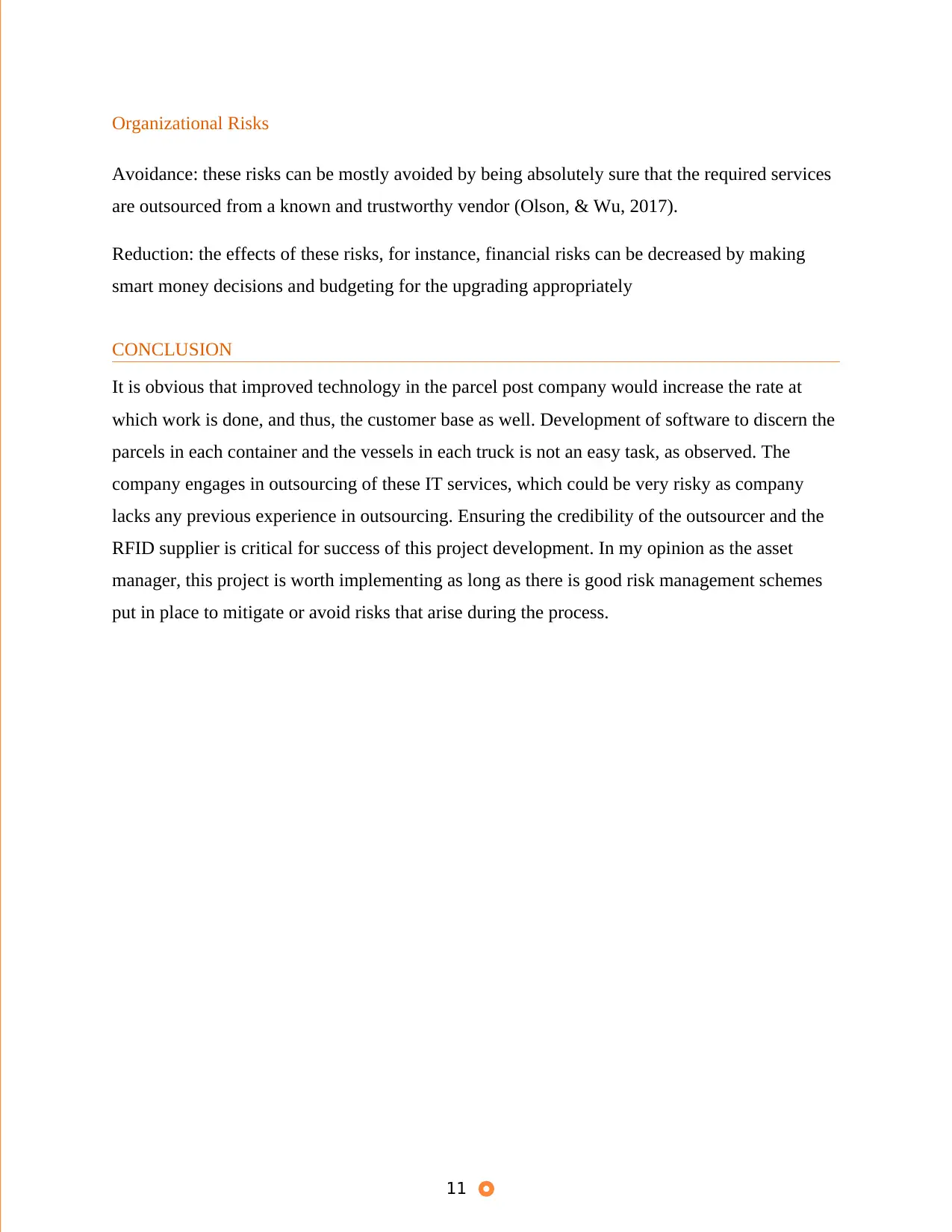
Organizational Risks
Avoidance: these risks can be mostly avoided by being absolutely sure that the required services
are outsourced from a known and trustworthy vendor (Olson, & Wu, 2017).
Reduction: the effects of these risks, for instance, financial risks can be decreased by making
smart money decisions and budgeting for the upgrading appropriately
CONCLUSION
It is obvious that improved technology in the parcel post company would increase the rate at
which work is done, and thus, the customer base as well. Development of software to discern the
parcels in each container and the vessels in each truck is not an easy task, as observed. The
company engages in outsourcing of these IT services, which could be very risky as company
lacks any previous experience in outsourcing. Ensuring the credibility of the outsourcer and the
RFID supplier is critical for success of this project development. In my opinion as the asset
manager, this project is worth implementing as long as there is good risk management schemes
put in place to mitigate or avoid risks that arise during the process.
11
Avoidance: these risks can be mostly avoided by being absolutely sure that the required services
are outsourced from a known and trustworthy vendor (Olson, & Wu, 2017).
Reduction: the effects of these risks, for instance, financial risks can be decreased by making
smart money decisions and budgeting for the upgrading appropriately
CONCLUSION
It is obvious that improved technology in the parcel post company would increase the rate at
which work is done, and thus, the customer base as well. Development of software to discern the
parcels in each container and the vessels in each truck is not an easy task, as observed. The
company engages in outsourcing of these IT services, which could be very risky as company
lacks any previous experience in outsourcing. Ensuring the credibility of the outsourcer and the
RFID supplier is critical for success of this project development. In my opinion as the asset
manager, this project is worth implementing as long as there is good risk management schemes
put in place to mitigate or avoid risks that arise during the process.
11
⊘ This is a preview!⊘
Do you want full access?
Subscribe today to unlock all pages.

Trusted by 1+ million students worldwide
1 out of 14
Your All-in-One AI-Powered Toolkit for Academic Success.
+13062052269
info@desklib.com
Available 24*7 on WhatsApp / Email
![[object Object]](/_next/static/media/star-bottom.7253800d.svg)
Unlock your academic potential
Copyright © 2020–2025 A2Z Services. All Rights Reserved. Developed and managed by ZUCOL.


